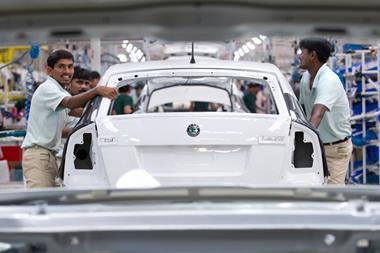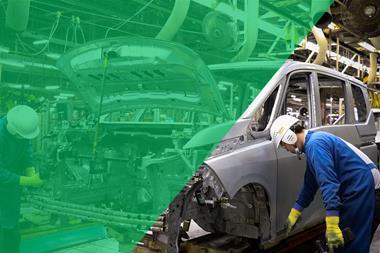
Finished vehicle quality on the Mercedes- Benz E-Class in Stuttgart
The three points of the Mercedes ‘star’ logo celebrate Gottlieb Daimler’s original ambition of seeing his engines used on land, sea and in the air. For a short while at least, he achieved his goal, as Daimler-branded engines were used in speedboats, airships and motorised vehicles. Although use of Daimler’s engines on the sea and in the air is now an historical footnote, Mercedes-Benz, a cornerstone of the larger company that bears Daimler’s name, continues to build on the inventor’s legacy, building cars, trucks and buses on five continents, Europe, North and South America, Asia and Africa.
Of the plants that make up this global production network, the largest is Sindelfingen, located near Daimler headquarters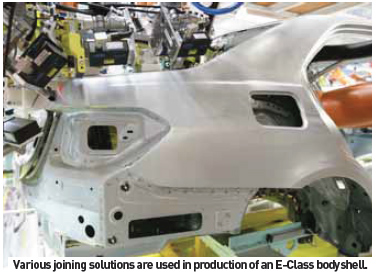 in Stuttgart, Germany. Encompassing 2.9km2, the plant employs approximately 28,000 people and features research and development, planning and procurement departments. The plant also incorporates a series of manufacturing facilities, producing models that range from the hand-built Maybach luxury saloon and SLS AMG supercar, through to series production of the S-Class, E-Class, C-Class, CL and CLS models.
in Stuttgart, Germany. Encompassing 2.9km2, the plant employs approximately 28,000 people and features research and development, planning and procurement departments. The plant also incorporates a series of manufacturing facilities, producing models that range from the hand-built Maybach luxury saloon and SLS AMG supercar, through to series production of the S-Class, E-Class, C-Class, CL and CLS models.
Dr. Ingo Ettischer, Director of E-Class Assembly at Sindelfingen, outlines the setup of his line. “We have two shops, on two floors. The main assembly line is on the upper floor, while the finish, end-of-line and rework areas are on the ground floor. Last year (2009), saw the ramp up of the new E-Class (W212) saloon and station wagon.”
 W212, S212 and C219 are the internal reference codes for the models under Ettischer’s control, respectively the E-Class saloon and estate, and the CLS four-door coupé. Production breakdown is approximately three-quarters saloon, with the remaining portion split between the estate and CLS models. Assembly is performed on two parallel production lines, with E-Class saloon and estate production on one and saloon and CLS assembly on the other. Model production includes two- and four-wheel drive (4MATIC) versions, with both petrol and diesel engines. AMG-badged versions are fitted with V8 engines delivered from the Mercedes-owned AMG factory, located in nearby Affalterbach. While limited CKD E-Class production takes place at various regional facilities, Sindelfingen manufactures 98% of all global volumes, with left- and right-hand drive variants homologated for markets outside mainland Europe, including the United Kingdom, Japan and the United States. From first weld through to final checks it takes four days for a car to travel through the production process. Bodyshell production and paint take one day each and final assembly requires two days, as weld and paint activities run over three shifts and assembly over two shifts. Additionally, each assembly line comprises 200 stations, a reflection on both the complexity of the cars and the varied model mix.
W212, S212 and C219 are the internal reference codes for the models under Ettischer’s control, respectively the E-Class saloon and estate, and the CLS four-door coupé. Production breakdown is approximately three-quarters saloon, with the remaining portion split between the estate and CLS models. Assembly is performed on two parallel production lines, with E-Class saloon and estate production on one and saloon and CLS assembly on the other. Model production includes two- and four-wheel drive (4MATIC) versions, with both petrol and diesel engines. AMG-badged versions are fitted with V8 engines delivered from the Mercedes-owned AMG factory, located in nearby Affalterbach. While limited CKD E-Class production takes place at various regional facilities, Sindelfingen manufactures 98% of all global volumes, with left- and right-hand drive variants homologated for markets outside mainland Europe, including the United Kingdom, Japan and the United States. From first weld through to final checks it takes four days for a car to travel through the production process. Bodyshell production and paint take one day each and final assembly requires two days, as weld and paint activities run over three shifts and assembly over two shifts. Additionally, each assembly line comprises 200 stations, a reflection on both the complexity of the cars and the varied model mix.
Getting back to quality
A cost-cutting exercise that continued into the mid-2000s served to severely damage the Mercedes reputation for delivering high-quality cars. It has taken a concerted effort to improve product quality and rebuild customer confidence, the finished vehicle improvements made through a series of changes in how quality is measured and the introduction of new processes on the production line.
“We are currently in a very good position in terms of quality,” confirms Ettischer. “We are meeting our internal quality targets, but external feedback from the market is also very good. External quality is measured using what we call the ‘Q Sensor’, a tool that measures finished vehicle quality by way of customer surveys.”
Over its seven-year lifecycle, the W211 (previousgeneration E-Class) underwent a series of improvements, yet Mercedes says the W212 entered production on an even better basis, with vehicle quality up 60% over the outgoing model. Further, quality issues surrounding electronic systems have also been eliminated, the Q Sensor index not reporting any negative feedback from this area in regards to the E-Class.
Ettischer goes on to highlight the internal changes put in place to further improve vehicle quality. “We have determined clear standards, standardized work processes. Every employee knows what they have to produce, in what sequence, in what way. Not just at the right point (in time) but how to do it. Each station includes a clear description of what the worker has to do, together with the amount of time these steps should take.”
The next step was to examine the stages leading up to production. “An interdisciplinary team from our development,
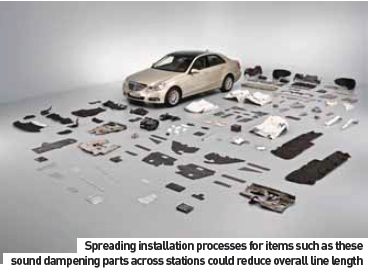
planning and production departments work in a joint ‘assembly-compatible’ product development process while preparing for each new model,” says Ettischer. “During the development phase of the W212, this team reviewed all processes concerning ergonomics, efficiency and quality, making the cars easier to build and better off the line.” He goes on to explain that cross-model part sharing has also improvd vehicle quality. “The C-Class and E-Class use some of the same parts. This module strategy between the product lines, using proven components, ensures a very high degree of maturity and quality right from the start.”
Efficiency on the line
Finished vehicle quality can also be affected by employee performance on the production line. As such, it is vital to maintain an on-going programme of continuous improvement in final assembly in order to streamline each individual production process and ultimately deliver an improved customer experience.
According to Dr. Ingo Ettischer, a key element of improving process efficiency is material presentation. “Within each takt on the assembly line, the worker has to walk in a triangle. If you’re able to reduce the length of this triangle, the walking path, you can pull waste out of the system and improve efficiency.” He goes on to explain that this is the basis of the company’s ‘line back’ principle, pulling waste away from the main line. The principle is further applied across the supply chain, covering the support areas, logistics, and ultimately the suppliers. “To eliminate waste, we need very good material presentation, smaller containers, best point presentation. The worker should always pick the part at the same point, they should not have to walk for one part and then another. We want the same part, at the same spot, every time.”
Ettischer says that the various factories across Sindelfingen have accumulated a ‘toolbox’ of approved processes that can be implemented in any assembly hall across the plant. “The goal is not to reinvent anything. Once we have found a good method, we try to do the same thing with our other models. We use internal benchmarking on the lines, within the different factories at Sindelfingen. We are always looking to learn from each other. Best-practise sharing is a key to improving processes.”
Although Mercedes-Benz previously employed external consultants to advise on what could be done to improve line efficiency, the method of continuous improvement has been brought back in-house. Collecting and acting on feedback received from line workers across the plant is now an integral part of the process. “We ask the people working on the line, the meisters (foremen), to share their knowledge and improve efficiency station by station. The other method is to optimize a series of stations at the same time, moving content from one station to another, with the goal of eliminating a whole station. One is a bottom-up view, improving a single process. The other is a more allencompassing view, a top-down view, improving the whole assembly line.”
In sharing smaller, individual operations between stations, Ettischer is attempting to make best use of the takts in those cells. Where a station might have to complete five or 10 separate operations within the allotted time, there might be another station which could perform two or three of these. Break this down further, adding three operations to three separate stations and the original station can be removed from the line.
In the final assembly area of the E-Class, where space is clearly limited, this methodology delivers additional benefits. “If we remove a station,” says Ettischer, “we could reduce the length of the belts and hand that floorspace back to logistics, who can then improve their process by bringing external kitting or pre-assembly processes within the building, closer to our assembly line. It’s a win-win situation.” One possible example of how this could work in practise is with the installation of the damping mat installed on the underside of the bonnet. By breaking down this process (part insertion, with associated screws and clips) into smaller, individual actions, the task could be redistributed over a number of surrounding stations, allowing the taskspecific cell to be removed from the line.
Good Ideas
Continuous improvement initiatives at Sindelfingen are used to streamline processes and reduce costs, but to also help employees connect with the Mercedes-Benz brand. “We understand that the company can only be successful with the co-operation of the employees,” says Ettischer. “Our new programme is designed to keep workers updated on what’s going on around the plant and offer improved training programmes. In turn, we want to catch all their knowledge, their ideas, and use these to build new efficiencies into the assembly line.”
Workshops of up to 50 people provide a forum for employees to put forward possible process changes, while also offering the opportunity to comment on team management and the overall work environment. Each area is then graded by the participants, using happy or sad faces. Ettischer reports there are a lot of happy faces on these evaluations, leading to the conclusion that all is well at Sindelfingen.
Yet while such meetings can serve to both motivate employees and open up communication channels, the fact of the matter is that Mercedes-Benz is continuously striving to achieve further improvements in efficiency. In Germany, where labour costs are notoriously high, automating processes could reduce the payroll, but is an employee likely to recommend their job be carried out by a robot if it means they will be unemployed?
Ettischer replies by saying that it is highly unlikely that any further automation will be added in his assembly hall. “Automation should make sense in terms of ergonomics, flexibility and economics; robots should be added where workers cannot comfortably achieve the task, this should be the focus. This is beneficial in terms of cost and overall return, but also in flexibility. People allow you to retain the flexibility needed to relay areas and change processes, otherwise you are too rigid and you cannot take advantage of new processes.”
He adds that Daimler is not a company that likes to lose employees. “At some companies, if they reduce hours-pervehicle by 10%, they lay off 10% of the workforce. That’s not the case here. We always have new ramp ups, new products coming online. I think that our employees are prepared to offer their insights, even if it means that they’ll be working in a different area afterwards. I think that’s a big difference between us and other OEMs and suppliers.”
With production of the W212 E-Class in place, Ettischer is preparing for the ramp up of the second-generation CLS Coupé. “This new car with its variants will be the next major challenge for us. Also, we have decided to introduce the CLS Shooting Break, another car which will be produced here.” Mercedes is planning to carry on with the current programme of continuous improvements to support the new model, with the goal of improving process efficiencies through co-operation with logistics, in terms of material presentation. Efforts will also be made to reduce hours per vehicle (HPV), one of the main areas used to benchmark efficiency improvements.
Ettischer adds that with the new car, he will be looking to further improve HPV build times. But after examining his current build process, are there additional benefits to be changed from reducing the takt time?
“Takt time is not the only factor in reducing HPV. The number of takts is equally important, if not more so. From a product side, there is also the question of reducing complexity in the production process, what can you do to reduce the effort needed to build the car, screwing, clipping, welds, etc. These elements drive complexity, so we work in close co-operation with our planning, design and product development departments, and of course, there are things we try to improve over a model’s lifecycle.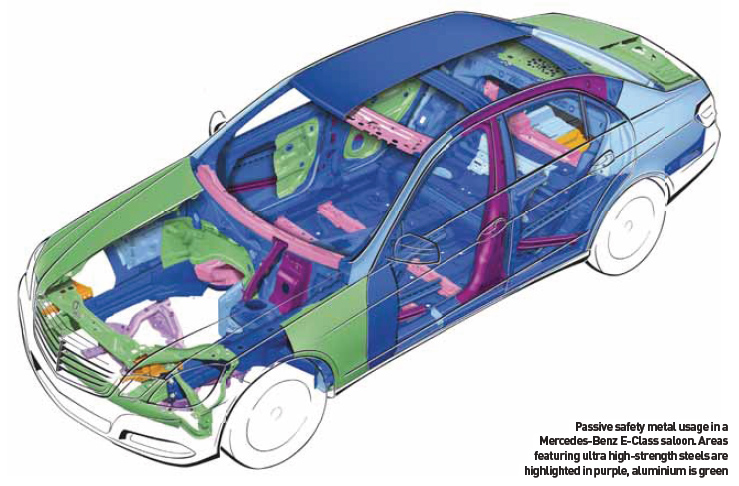
Mercedes-Benz E-Class production
Press shop
The press shop at Sindelfingen produces parts in pre-set batch sizes, supplying the body shops on site and also at the Mercedes facility in Rastatt, home to A-Class and B-Class production. After completing the ordered part quantity, each die is manually checked before being returned to storage. Dies for model-specific pressings are colour-coded; yellow for E-Class, pink for S-Class and green for A- and B-Class. Finished panels are removed and inspected by hand before being hung in carriers and taken to a logistics processing area. Parts are delivered as required to the bodyshop using an automated transfer system.
The press shop uses 3,000 metric tonnes of steel and 140 metric tonnes of aluminium per week to manufacture E-Class parts for the body shop. The steel coil and sheet aluminium is first cut into generic press-cut blanks. Tandem and transfer presses are used to produce all parts, from basic components through to complex body panels. Presses produce between 10 and 50 parts per minute depending on part size and process complexity. At maximum capacity, the transfer press has an output of four components per hit, for example pressing inner and outer left- and right-hand door parts simultaneously.
Outer bonnet panels for E-Class production are manufactured in the tandem press using a four-stage process, with the parts being moved between stamping operations by a series of Kuka robots. The raw blanks are first shaped in a 2,800 metric tonne press, followed by two cutting operations to trim excess material. The last pressing operation adds final shaping to the part and cut outs in the bonnet. Waste material is returned to steel mills for reuse. While it takes four days to produce an E-Class from start to finish, this does not include press shop activities, as the time taken to produce a vehicle is measured from when it is assigned an owner and this only happens upon the first weld in the bodyshop.
Bodyshop
The first operation in the bodyshop is to weld the individual engine, floor panel and boot compartment pressings to create  a complete floorpan. Material thickness for these parts ranges from 0.6mm to 1.7mm, the thicker material used to reduce interior cabin noise and improve crash performance. The second main operation is adding the bodysides and roof, with the front and rear wings and closures mounted and fixed to the body in a third round of welding.
a complete floorpan. Material thickness for these parts ranges from 0.6mm to 1.7mm, the thicker material used to reduce interior cabin noise and improve crash performance. The second main operation is adding the bodysides and roof, with the front and rear wings and closures mounted and fixed to the body in a third round of welding.
While most joints in an E-Class bodyshell are performed using resistance spot welding, other joining techniques are used where the material combination or flange prohibits this type of operation. “An E-Class body includes a mix of materials,” says Sebastian Streuff, Head of Production Process Efficiencies, “from aluminium to ultra high-strength steels. On the door frame, steel is joined using laser welding, due to the materials used and the narrow flange of the pressed panels. In other areas, clinching is used to join aluminium parts, such as in the boot lid.”
A key element of the welding area are the robotic grippers used to move and position parts within individual cells. Developed in co-operation with Audi, Volkswagen ad BMW, they are standardized units that can be replaced individually as required. “If there is a problem, the complete gripper arm doesn’t need to be replaced. It is an inexpensive modular unit that can be changed without interfering too much with production,” says Streuff.
In the bodyshop, a blown-out E-Class bodyshell serves to demonstrate both the number of individual parts used to create a complete body and also where specific materials are used within the car. “Ultra high-strength steel is used in the lateral areas and B-pillar to improve side impact collision performance,” says Streuff. “It is the best material currently available in the automotive industry, with a tensile strength of 1,500N/mm2. Most materials in the car can be coldstamped, but this part must be hot formed. Outer panels have a good strength-to-weight ratio, with a good surface for painting. Aluminium parts include the bonnet, wings, rear parcel shelf and boot lid, while the only plastic part on the outside of the car is the filler cap cover.”
Also in this area is one of the 500 cars that are crash-tested at Sindelfingen each year. Subjected to a front-offside impact test conducted at 56km/h, the vehicle serves to demonstrate how the bodyshell transmits impact forces around – and not through – the passenger safety cell. Of particular note is the deformation of the C-pillar, as it too is designed to absorb impact forces.
Paint
Seven coats of paint are applied to each car body as it advances through the paintshop, in a series of application, flash-off processes. The first of these is a cataphoretic dip primer, where the electrically-charged bodyshell attracts paint particles suspended in the dip solution. The next six top coats are applied by robots, using an electrostatic process. At the conclusion of each stage, the paint is not completely dry, as it must retain some adhesive qualities in preparation for the next coat. In total, the paint process adds 20kg to the vehicle weight.
Final assembly
Fully 10% of E-Class assembly operations at Sindelfingen are carried out without manual intervention, including the application of sunroofs, panoramic sunroofs and instrument panels. As a percentage of all operations, it is more than double that of most other final assembly plants, but Dr. Ingo Ettischer says that the automation addresses ergonomic concerns and is not an attempt to reduce labour costs. Mercedes says that automating sunroof installation has improved process times by 15%. The installation process first involves the glass (not polycarbonate) roof unit having glue applied at 60oC, with the unit moving around the feeder head to receive the adhesive bead. The standard sunroof is inserted by robots through the windscreen opening, while the panoramic roof is applied from above the vehicle, with 300kg of pressure.
“Roof, cockpit and marriage operations are all automated,” says Ettischer. “Door seals are also applied automatically, this was a process introduced for the new C-Class and adapted for use with the E-Class. Add more automation, you become that much more inflexible. Automated stations can’t change to take advantage of continuous improvement initiatives.”

































